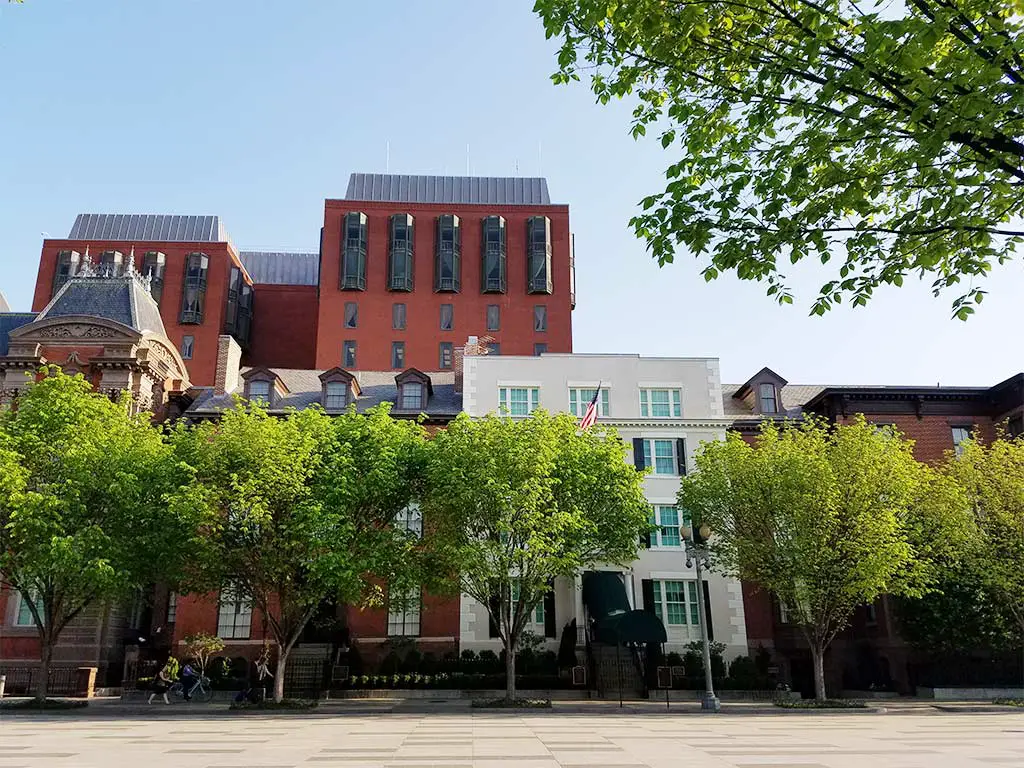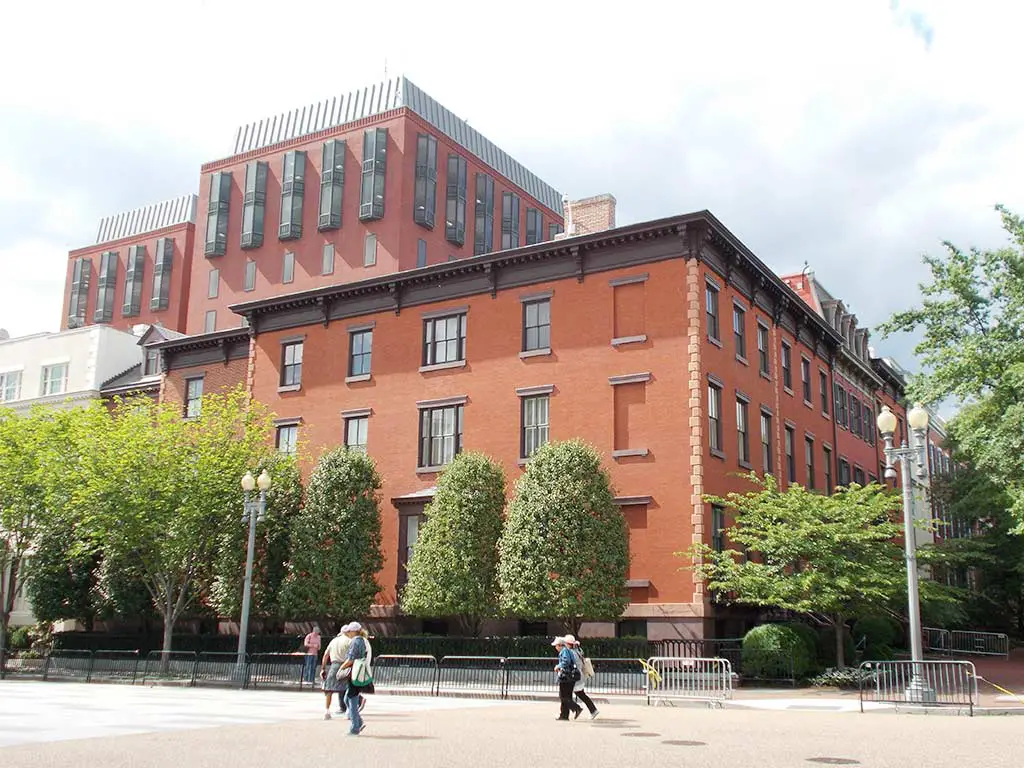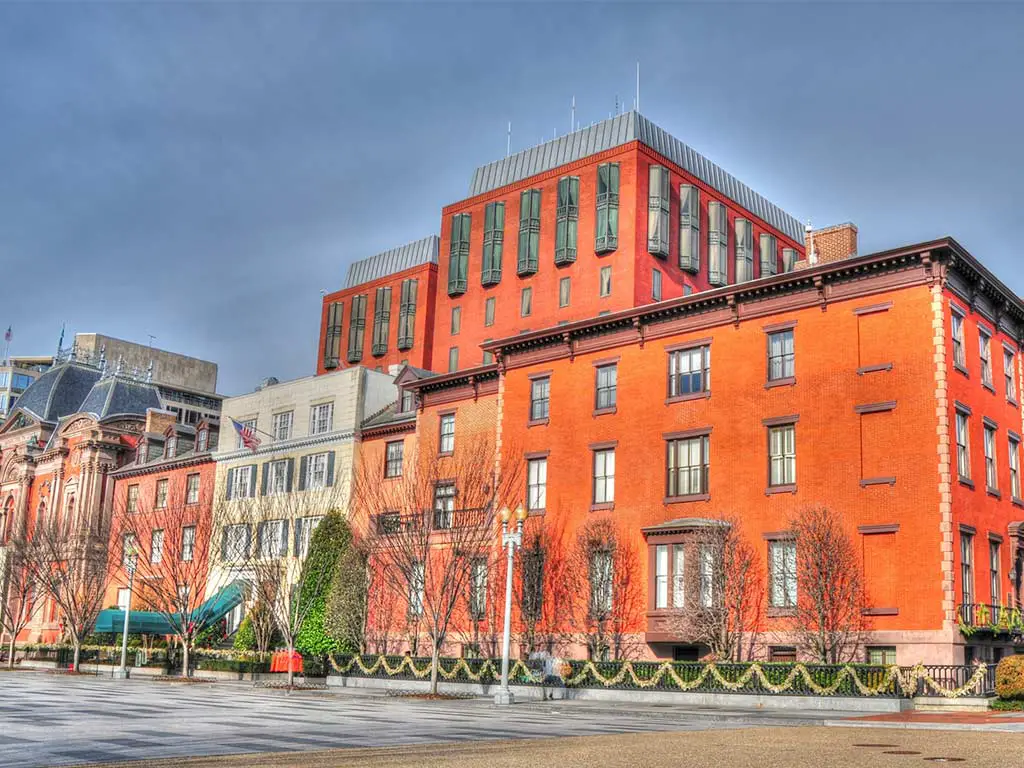Step into the rich tapestry of American history at Blair House, a place where pivotal decisions have shaped the course of our nation.
Located in the heart of Washington DC, Blair House stands as a silent witness to the small but significant moments that have defined America’s story.
Built in 1824, this historic residence became a political hub when the Blair family made it their home in 1837.
Over the years, Blair House has hosted a myriad of distinguished guests, from world leaders like General Charles de Gaulle and Queen Elizabeth II to iconic figures such as Nelson Mandela and Margaret Thatcher.
Serving as a cornerstone of American diplomacy, Blair House has been the backdrop for crucial international events, fostering relationships with nations across the globe.
As you explore the corridors of this iconic landmark, you’ll immerse yourself in the legacy of diplomatic excellence that continues to unfold within its walls.
Blair House: A Historical Overview

Blair House holds a significant place in American history, serving as the official guest residence of the President of the United States.
Here’s an overview of its historical significance:
The Origins and Evolution
Blair House, located in Washington DC, has a rich history that dates back to its construction in 1824. Originally built as a private residence, it became a political hub in 1837 when the Blair family took up residence.
Over the years, Blair House has evolved from a familial abode to a significant landmark in American diplomatic history. Its evolution mirrors the changing landscape of American politics and international relations.
Blair House’s significance in American diplomatic history is further highlighted by its role as the President’s Guest House, hosting numerous foreign dignitaries and serving as a symbol of hospitality and diplomacy for over a century.
Role as the President’s Guest House
Blair House serves as the official guest house for the President of the United States. Its role has been pivotal in hosting distinguished guests, including world leaders and prominent figures from various nations.
As the President’s Guest House, Blair House plays a crucial role in diplomatic engagements and symbolizes the hospitality and diplomatic etiquette of the United States.
With its rich history dating back to the 19th century, Blair House in Washington DC stands as a symbol of diplomatic excellence and historical significance.
Throughout the years, it has served as a place for important meetings and discussions between world leaders, showcasing its importance on the global stage.
Architectural Significance

Blair House, with its rich history and architectural significance, stands as a notable landmark in Washington, D.C.
Here’s a closer look at its architectural features and significance:
Key Architectural Features
Blair House boasts a rich history of architectural significance, with its distinct design elements showcasing a blend of various styles over the years.
From the original marble mantels with intricate carvings, including motifs like bulls eyes and sheep, to the more ornate features adorning the interior, each detail reflects a unique aspect of American craftsmanship.
The preservation of these original design elements not only highlights the elegance of the past but also serves as a testament to the connection between historical preservation and architectural beauty.
Expansion and Unification
The renovation efforts at Blair House between 1982 and 1988 marked a significant phase in its history, reflecting a commitment to preserving its architectural heritage while adapting to modern needs.
The seamless integration of the four houses’ floor plans and the addition of a two-story garden wing not only expanded the property but also unified its interior spaces.
The inclusion of elements from different eras in the interior design created a cohesive plan, blending the charm of the past with contemporary functionality.
Private citizens’ contributions to the renovation project further underscored the importance of preserving Blair House’s historical and architectural significance for future generations.
Notable Historical Events

Blair House has witnessed several notable historical events throughout its existence, contributing to its significance in American history.
Here are some key moments:
Diplomatic Agreements and Treaties
Blair House has been a significant setting for numerous diplomatic agreements and treaties throughout history. Hosting world leaders and diplomats, the residence has witnessed pivotal moments in international relations.
The ambiance of Blair House, with its rich history and symbolic importance, has facilitated discussions that have shaped global politics.
From formal treaty signings to informal negotiations, the house has played a crucial role in fostering diplomatic relations between nations.
Its strategic location near the White House makes Blair House an ideal venue for hosting diplomatic events and high-profile guests.
With its historical significance and elegant surroundings, Blair House continues to serve as a cornerstone for international diplomacy in Washington, DC.
Presidential Uses and Important Guests
Over the years, Blair House has been a focal point for presidential activities and has welcomed a myriad of important guests.
Serving as the official guest house for the President of the United States, it has accommodated foreign dignitaries, heads of state, and other prominent figures from around the world.
The house’s prestigious status and historical significance make it a preferred choice for hosting high-profile events and formal meetings.
With its unique blend of architectural grandeur and historical charm, Blair House continues to uphold its legacy as a symbol of American hospitality and diplomacy.
Preservation and Management
Preservation and management of Blair House involve a combination of historical conservation efforts, security measures, and logistical coordination to ensure its continued function as the official guest residence of the President of the United States.
Here’s an overview of how Blair House is preserved and managed:
The White House Historical Association
The White House Historical Association plays a vital role in the preservation and management of Blair House.
Since 1965, this esteemed association has been instrumental in funding and showcasing official portraits of presidents and first ladies, contributing significantly to maintaining the historical legacy of esteemed residences like Blair House.
Through its commitment to supporting historical preservation, the White House Historical Association helps capture the essence of American history and diplomacy, enriching the cultural tapestry of significant landmarks like Blair House for generations to come.
Conservation Efforts
Conservation efforts at Blair House focus on maintaining the architectural integrity and historical significance of this iconic residence.
Renovations between 1982 and 1988 exemplify a commitment to preserving the heritage of Blair House while adapting it to contemporary needs.
These efforts aimed to not only expand and unify the property but also ensure that its unique blend of architectural styles, reflecting American craftsmanship and sophistication, remains intact.
By incorporating different eras in the interior design, conservation practices at Blair House emphasize the harmonious coexistence of the past and present.
This dedication to conservation not only safeguards the historical value of Blair House but also underscores the importance of preserving its rich legacy for future generations to appreciate and cherish.
Historical Events

Blair House has been witness to several historical events throughout its existence, reflecting its significance in American history.
Here are some notable examples:
President Andrew Jackson and the “Kitchen Cabinet”
President Andrew Jackson’s term in office marked a pivotal point in Blair House’s history. Jackson’s official Cabinet faced internal divisions between Vice President John C. Calhoun and Secretary of State Martin Van Buren, leading to inefficacy.
To circumvent this, Jackson established an informal group called the Kitchen Cabinet, where Francis Preston Blair played a significant role.
This group of trusted advisors provided critical support until its decline in 1831. Blair House’s historical significance continued to evolve after the decline of Jackson’s Kitchen Cabinet in 1831.
Over the years, it has served as a crucial location for hosting foreign dignitaries and accommodating visiting heads of state, solidifying its role as a vital piece of Washington D.C.’s diplomatic landscape.
The Globe & Congressional Globe
As the editor of the Globe and Congressional Globe, Francis Preston Blair wielded considerable political influence.
His publications were instrumental in shaping political discourse and garnered attention from key figures, including Presidents Jackson and Lincoln.
The Congressional Globe, later known as the Congressional Record, remains a key publication in U.S. politics, showcasing Blair’s lasting impact.
Blair House in Washington, DC holds significant historical importance as the official guest residence for foreign dignitaries visiting the United States.
Its rich history includes hosting notable figures and witnessing key diplomatic events, making it an iconic landmark in American diplomacy.
Webster-Ashburton Treaty
Blair House’s historical relevance extends to pivotal diplomatic events such as the Webster-Ashburton Treaty. Negotiated in 1842, this treaty resolved border disputes between the U.S. and Britain.
The negotiations, which may have touched Blair’s connections, showcased the residence as a site of diplomatic significance and historical importance.
Blair House’s rich history also includes hosting various foreign dignitaries and heads of state over the years, further solidifying its reputation as a symbol of diplomacy and international relations in Washington, DC.
Secession and General Lee
Blair House intersected with the national narrative during the secession crisis and the offer of command to General Robert E. Lee.
In a turning point in American history, Lee declined the Union command at Blair House, ultimately becoming a central figure in the Confederacy’s military successes. This moment marked a critical juncture that shaped the course of the Civil War.
The historical significance of Blair House in Washington, DC is deeply intertwined with pivotal moments like the secession crisis and General Robert E. Lee’s refusal of the Union command there.
This decision played a crucial role in shaping the outcome of the Civil War and highlighting Blair House’s role in American history.
General Tecumseh Sherman
Blair House witnessed the marriage of General William Tecumseh Sherman to Ellen Ewing in 1850, a union that would later tie Sherman to significant military campaigns during the Civil War.
The presence of notable figures at Blair House underlines its role as a backdrop for significant historical events and gatherings.
Blair House in Washington DC has served as a significant historical venue, hosting notable figures and events such as the marriage of General William Tecumseh Sherman to Ellen Ewing in 1850.
This union later influenced Sherman’s involvement in key military campaigns during the Civil War, highlighting Blair House’s rich history as a backdrop for pivotal moments.
World War II
Blair House’s narrative expanded during World War II when it became instrumental in diplomatic efforts. The purchase of Blair House by the U.S. Government in 1942 highlighted its evolving role in accommodating key figures during crucial moments in American history.
This transition underscored the residence’s enduring significance in diplomatic and political spheres.
Blair House’s importance continued to grow post-World War II, solidifying its status as a pivotal location for hosting esteemed guests and facilitating diplomatic discussions.
The house remains a symbol of historical significance and diplomatic excellence in Washington DC.
Truman at Blair House
President Harry Truman’s residence at Blair House from 1948 to 1952 symbolized a unique chapter in its history.
Truman’s stay was necessitated by renovations at the White House, showcasing Blair House’s adaptive role in accommodating presidents during transitional periods.
This period solidified Blair House’s reputation as a cornerstone of American hospitality and diplomatic history.
The significance of President Harry Truman’s residency at Blair House during 1948 to 1952 highlights the historical importance of this institution in supporting presidents during times of transition, underscoring its enduring role in American hospitality and diplomacy.
Frequently Asked Questions
What is the historical significance of Blair House?
Blair House has been a political hub since the Blair family moved in during 1837, hosting distinguished guests. It embodies American diplomacy as the official guest house for the President of the United States.
What organization has funded and showcased official portraits of presidents at Blair House since 1965?
The White House Historical Association has funded and showcased official portraits of presidents and first ladies at Blair House since 1965.
What is the focus of conservation efforts at Blair House?
Conservation efforts at Blair House focus on maintaining its architectural integrity and historical significance, ensuring the unique blend of styles reflecting American craftsmanship remains intact.
What historical events are associated with Blair House?
Blair House has historical relevance through events like the Webster-Ashburton Treaty in 1842, the secession crisis, and notable figures like Robert E. Lee, William Tecumseh Sherman, and Harry Truman, solidifying its reputation as a cornerstone of American hospitality and diplomatic history.
Conclusion
Preserving Blair House’s historical legacy is crucial in maintaining the cultural heritage and architectural significance it holds.
The house’s blend of styles, reflecting American craftsmanship, embodies a rich tapestry of American history and diplomacy.
Renovations from 1982 to 1988 not only expanded the property but also upheld its heritage while meeting modern needs, showcasing a harmonious integration of different eras in its interior design.
The White House Historical Association’s contribution since 1965 in funding and displaying official portraits of presidents and first ladies at Blair House has been instrumental in upholding its historical significance.
This ongoing commitment highlights the importance of preserving Blair House for future generations to cherish and understand the essence of American diplomacy embedded in its walls.




Allison Brice